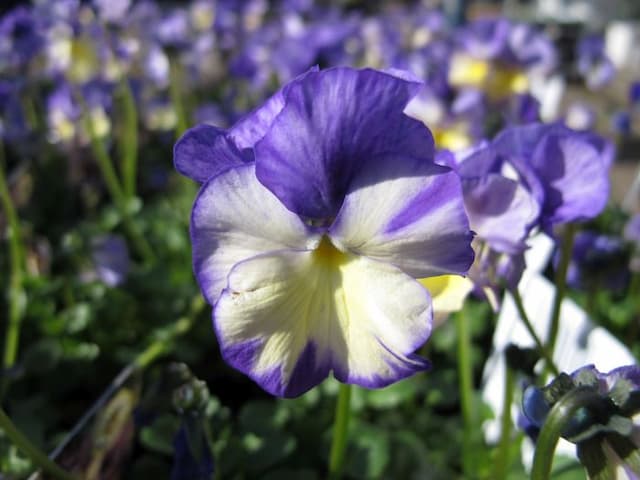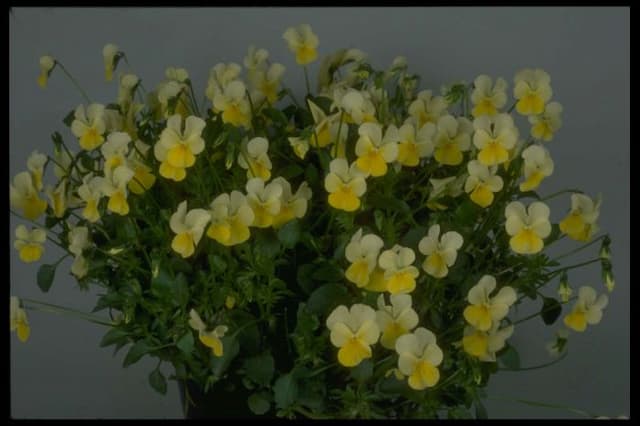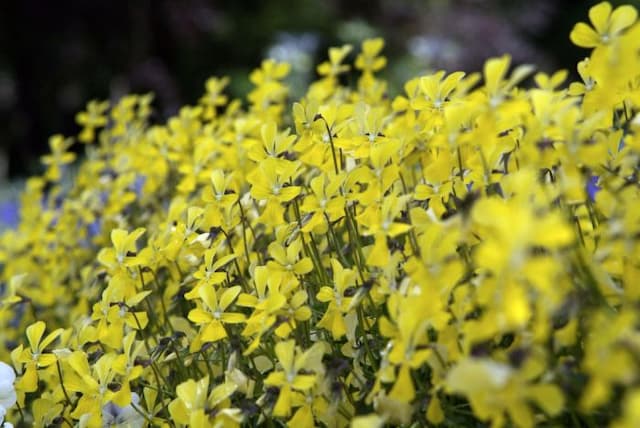Heartthrob Viola Viola 'Heartthrob' (v)

ABOUT
The Viola 'Heartthrob', also known simply as Heartthrob violet, has a charming and distinctive appearance. The most captivating feature is its heart-shaped leaves, which immediately draw the eye with their deep green color and striking burgundy center resembling a heart within a heart. The combination of colors gives this plant a romantic and appealing look, setting it apart from other varieties of violets. Upon closer observation, you will notice the delicate flowers that the Heartthrob violet produces. The blossoms come in a delightful shade of purple, and they typically have a subtle, lighter center, often with a touch of yellow that highlights the heart of the flower. These flowers present a beautiful contrast against the bold foliage, creating a visually harmonious display. The velvety texture of the plant's leaves and the gentle ruffled edges of the petals enhance its overall tactile and aesthetic appeal. The growth habit of the Heartthrob violet is such that it forms a neat and low clump, allowing the foliage and blooms to cover the plant beautifully, making it an attractive candidate for ground cover, borders, or decorative containers. Overall, the Viola 'Heartthrob' exudes charm and beauty through its contrasting colors, heart-shaped leaves, and lovely flowers, boasting an endearing appeal that can captivate the hearts of plant enthusiasts and garden visitors alike.
About this plant
 Names
NamesFamily
Violaceae
Synonyms
Heartthrob Violet, Sweetheart Violet, Valentine Violet
Common names
Viola 'Heartthrob'
 Characteristics
CharacteristicsLife cycle
Perennials
Foliage type
Evergreen
Color of leaves
Green
Flower color
Purple
Height
0.5 feet (15 cm)
Spread
1 foot (30 cm)
Plant type
Herb
Hardiness zones
5
Native area
Europe
Benefits
 General Benefits
General Benefits- Ornamental Value: The Viola 'Heartthrob' offers a striking display with its heart-shaped leaves and vibrant flowers, enhancing the aesthetic appeal of gardens and landscapes.
- Low Maintenance: It requires minimal care and is relatively easy to grow, which makes it suitable for novice gardeners and those looking for low-effort gardening options.
- Seasonal Interest: With its bloom period spanning across multiple seasons, it provides continuous visual interest throughout its growing season.
- Attracts Wildlife: The flowers attract pollinators such as bees and butterflies, encouraging biodiversity in the garden environment.
- Ground Cover: Its growth habit is useful for covering bare spots in the garden, helping to suppress weeds and maintain soil moisture.
- Edibility: The flowers of some viola species are edible and can be used to add color and a mild flavor to salads and desserts, though one should always make sure the specific variety is safe for consumption.
- Companion Planting: Violas can be used in companion planting to enhance the growth and flavor of certain vegetables and to deter pests.
- Container Gardening: Suitable for pots and containers, violas offer versatility for those with limited garden space or who prefer patio gardening.
 Medical Properties
Medical PropertiesThis plant is not used for medical purposes.
 Air-purifying Qualities
Air-purifying QualitiesThis plant is not specifically known for air purifying qualities.
 Other Uses
Other Uses- Artistic inspiration: The striking pattern and colors of the Heartthrob viola can inspire artists and designers, influencing artworks, fabric designs, and decorative motifs.
- Photography focus: Their unique heart-shaped markings make them popular subjects for photographers looking to capture the beauty of nature and create compelling plant portraits.
- Signature garnish: Petals of the Heartthrob viola can be used as an edible garnish on desserts and cocktails for a touch of elegance and color.
- Education teaching tool: Botany educators can use the Heartthrob viola to demonstrate plant hybridization and the diversity of flower forms and patterns.
- Floral crafts: Dried Heartthrob petals can be used in creating bookmarks, greeting cards, or pressed flower arrangements.
- Mood enhancer: The bright and joyful appearance of the Heartthrob viola can be used in horticultural therapy to uplift spirits and improve emotional well-being.
- Event decor: The distinct appearance of Heartthrob violas makes them ideal for use in event decorations, such as weddings and parties, to add a personalized and romantic touch.
- Fairy gardens: Heartthrob violas are suitable for miniature fairy garden landscapes, offering whimsical charm and pretend habitats for fairy figurines.
- Eco-friendly confetti: The petals of the Heartthrob viola can be used as biodegradable confetti for celebrations, reducing the environmental impact compared to traditional plastic confetti.
- Color palettes: The viola’s unique coloration can inspire interior designers and homeowners to create color schemes for home décor and paint selections.
Interesting Facts
 Feng Shui
Feng ShuiThe Heartsease is not used in Feng Shui practice.
 Zodiac Sign Compitability
Zodiac Sign CompitabilityThe Heartsease is not used in astrology practice.
 Plant Symbolism
Plant Symbolism- Love: With its heart-shaped leaves and affectionate name, 'Heartthrob' is often associated with deep love and passion.
- Innocence: Violets in general symbolize innocence and purity, which may carry over to the 'Heartthrob' variety.
- Humble Modesty: Historically, violets have been connected to modesty due to their small and unassuming flowers that often grow close to the ground.
- Spiritual Wisdom: In some traditions, violets represent spiritual insight and enlightenment.
- Faithfulness: The enduring quality of the violet's fragrance after it has been picked symbolizes loyalty and steadfastness.
 Water
WaterThe pansy 'Heartthrob' prefers consistent moisture, so it should be watered when the top inch of soil feels dry to the touch. This may mean watering once or twice a week, depending on climate conditions and soil type. Use room temperature water, and aim to provide enough water so that it reaches the roots without waterlogging the plant, typically about 1 gallon per week. It's critical to avoid overhead watering to prevent fungal diseases; water at the base of the plant instead. During hotter, drier periods, more frequent watering may be necessary.
 Light
LightPansies like 'Heartthrob' flourish in full to partial sunlight. The ideal spot for planting pansies is one where they can receive morning sunlight and some afternoon shade, especially in regions with hot summers. Too much heat can cause pansies to become leggy and reduce blooms, so providing some shade during the hottest part of the day helps to keep them healthy and vibrant.
 Temperature
TemperaturePansies, including the 'Heartthrob' variety, prefer cooler temperatures and can struggle in hot conditions. They thrive in temperatures between 40°F and 60°F but can survive minimum temperatures down to 25°F and maximum temperatures up to 80°F. For best growth and flowering, keep pansies in an environment where the temperature remains within their ideal range.
 Pruning
PruningPrune pansies like 'Heartthrob' to remove spent flowers, a practice known as deadheading, which encourages more blooms. Light pruning can be done throughout the blooming season to maintain the plant's shape and encourage new growth. The best time for more extensive pruning or cutting back is late winter or early spring, just before new growth begins.
 Cleaning
CleaningAs needed
 Soil
SoilFor Heartsease, the best soil mix is light, fertile, well-draining with compost or peat additive. Soil pH should be slightly acidic to neutral, ranging from 6.0 to 7.0.
 Repotting
RepottingHeartsease typically requires repotting every 1-2 years or when rootbound to maintain good health.
 Humidity & Misting
Humidity & MistingHeartsease prefers moderate humidity levels. Aim for a humidity range of 40-60% for optimal growth.
 Suitable locations
Suitable locationsIndoor
Place Heartsease in bright, indirect light indoors.
Outdoor
Grow Heartsease in partial shade to full sun outside.
Hardiness zone
4-9 USDA
 Life cycle
Life cycleViola 'Heartthrob', commonly known as Heartthrob Violet, begins its life cycle when seeds are sown into well-draining soil in a cool, shaded environment, typically in late winter to early spring. Seedlings emerge and gradually establish a small rosette of heart-shaped, decorative leaves with a central silver or white marking. Throughout spring and into summer, the plant matures and produces its characteristic small yet vivid flowers, often in shades of deep violet or purple with a small yellow center, attracting pollinators to assist in reproduction. After flowering, the Heartthrob Violet sets seed, which can be collected for propagation or naturally dispersed by wind, animals, or self-sowing. During the autumn, growth slows down, and the plant may die back, becoming dormant through the winter, especially in areas with colder climates. In the following spring, if the plant has not been annual, it will emerge from dormancy and begin the growth cycle anew, with established plants producing offsets that can be divided to propagate new plants.
 Propogation
PropogationPropogation time
Spring-Early Summer
Propogation: The Viola 'Heartthrob', more commonly known as Heartthrob Violet, is often propagated through division, which is typically done in the spring or fall. To propagate by division, carefully dig up the plant, making sure to keep a good amount of roots on each piece. Gently separate the plant into smaller sections, each with its own roots and shoots. These individual sections can then be replanted into well-prepared soil, spaced about 6 to 12 inches (approximately 15 to 30 cm) apart to allow for growth. Water the newly planted divisions thoroughly after planting. This method maintains the characteristics of the parent plant and is one of the simplest ways to produce new Heartthrob Violets.









